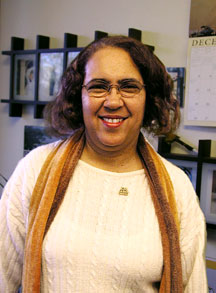

Nine Safety Tips for the Holidays
By Mika Ono
Denise Devall, a safety coordinator at The Scripps Research Institute, has had to learn to love the holiday season. A single parent with five children, she knows the meaning of "holiday overload."
"I've had my own personal experience with the hazards of the season," she says. "Seven years ago, around Christmastime, I drove myself to urgent care with chest pains. They told me I had to learn to manage my stress or next time they would come and pick me up."
Devall took the warning seriously, and now, instead of worrying that all her presents might not be perfect, she focuses on the essentials. "For me, the holidays are really about getting together with family and enjoying each other's company," she says. "If money is tight, we can just make do with less."
A 17-year veteran of the safety field, Devall draws on her personal and professional experience for her top holiday safety tips:
• Don't Drink and Drive. It's a well-worn refrain, but a good one. If you are going to a party where alcohol is served, use a designated driver.
• Watch Out for Weather. "Be aware of how weather affects driving conditions," Devall says. "If the weather is bad, slow down and keep extra distance between cars to prevent collisions." Devall notes that giving yourself extra travel time can help you keep your patience and pay attention to other drivers on the road. For other safe driving tips refer to http://www.dmv.ca.gov/pubs/hdbk/driver_handbook_toc.htm.
• Keep Christmas Trees Safe. Inspect natural trees for freshness and water daily. A large number of brittle or fallen needles indicate your tree could be becoming a fire hazard. Also, use non-combustible or flame retardant materials for decorating.
• Be Aware of Electrical Hazards. Inspect strings of lights for frayed wires or broken bulbs in the sockets-replace the entire string if you find this type of damage. Roughly one-third of Christmas tree fires are started by bulbs, lamps, or lighting. One-quarter were stared by cords and plugs (Source--NFPA survey). Don't use electrical decorations on metallic trees or staple them to the wall. Turn off lights prior to leaving the house. ("Be aware," Devall cautions. "Ask yourself questions like, 'Is stapling the lights to the wall really such a good idea?'")
• Choose Age-Appropriate Gifts. Watch out for small parts that babies, toddlers, and pets can choke on. Look at toy (boxes) packaging for age recommendations and at the U.S. Consumer Product Safety Commission web site [http://www.cpsc.gov] for updated lists of unsafe items.
• Wash Your Hands. Washing your hands frequently with soap and water can help you avoid catching colds and spreading germs. The Centers for Disease Control (CDC) suggests use of alcohol-based gels and wipes for people on the go.
• Keep Hot Foods Hot and Cold Foods Cold. Food poisoning can result from improper handling of food. The California standard for hot food is 135 degrees Fahrenheit (57.2 degrees Celsius); for cold food, 41 degrees Fahrenheit (5 degrees Celsius). The CDC estimates that 76 million Americans get sick from food borne illnesses, over 300,00 are hospitalized, and 5,000 die each year.
• Use Separate Cutting Boards for Meats and Vegetables. Devall notes that keeping food preparation areas clean will also help prevent food-borne illness.
• Take Care of Yourself. In addition to preventing chest pains, taking care of yourself has many safety benefits. Eating regularly, taking the time to sleep and exercise, avoiding a frenzy of overspending and overextending helps you maintain good judgement and common sense.
"You can only do so much," Devall says. "It's OK to slow down and breathe deeply."
For additional safety information, contact the Scripps Research Environmental Health and Safety Department, x4-8240.
Send comments to: mikaono[at]scripps.edu

"You can only do so much," Safety Coordinator Denise Devall says. "It's OK to slow down and breathe deeply." Photo by Kevin Fung.
